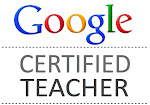I spent my morning learning with over 200 educators, and I didn't even leave my house! I participated in EdCampHome 2.0!
These talented educators assembled 266 EdCampers together in a Google+ community, facilitated the development of session ideas, coordinated moderators for each YouTube session, and then populated each session via email invitation to a Google HangOut.
These Ed Tech leaders accomplished it all with cool confidence, positive attitudes, and a sense of humor!
It was a remarkable experience!
Weeks before the EdCampHome event, members joined a Google + Community and introduced themselves. I shared some information about myself, and of course included some holiday cheer from Buck!
This morning, I set up my laptop and a backup one and an ipad :-), grabbed a cup of coffee, and plugged in my headphones. Headphones are helpful when joining a Google HangOut. Without them, your voice might echo during the session.
(Sorry, Buck. I'll be with you in three hours.)
A live Google HangOut was going on throughout the EdCampHome. You could hear the organizers typing feverishly to build the sessions and trouble shooting with one another.
What a team!
Once I filled out a form selecting a session, I received an email confirming it. The email included useful links to the Helpdesk and the EdCampHome.
Once in the session, people clicked on the Toolbox and added a name tag. In Google HangOuts, the name tag is called the lower third. On the right, people could chat with one another or add relevant links to the discussion.
I attended a session about using Evernote in the classroom. This was a session I had recommended. It was moderated by Kevin Ashworth, a CUE friend of mine. Moderators volunteer to open up a Google HangOut Online and keep the conversation moving along. Kevin did a fabulous job!
A few teachers in the session were using Evernote effectively in their classrooms and shared. Sharon Plante showed the group a jot pen penultimate that she likes using in conjunction with Evernote.
The group committed to sharing some tutorials and resources in the Google+ community. I hope we will be able to continue to support one another with developing an effective Evernote classroom system.
Here is the Evernote EdCampHome recording:
The second sessions I attended was about Virtual Field Trips, and it was lead by another fantastic moderator, Christine Hartooni. A great resource that came up was Google's Connected Classrooms. I look forward to tapping into the resources and connections provided in the Google community.
Here is the EdCampHome Virtual Field Trips recording:
All of the recorded sessions can be viewed here.
What do you think of the idea of an EdCamp?
What sessions would interest you?





.JPG)
.JPG)




.jpeg)
.jpeg)




.JPG)
.JPG)
.JPG)
.JPG)
.JPG)
.JPG)
.JPG)
.JPG)
.jpeg)











































